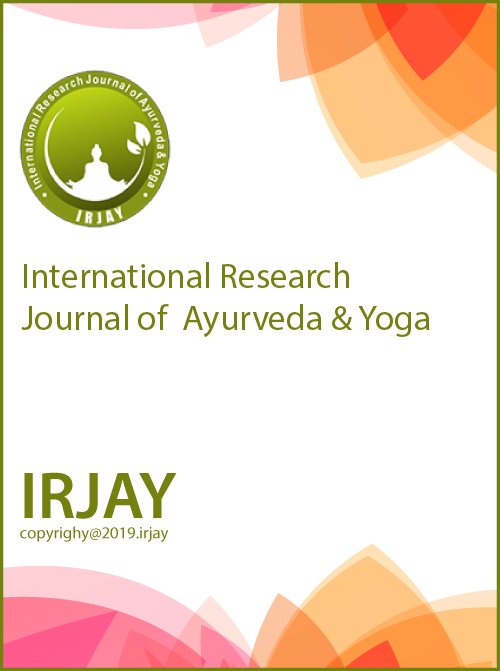Clinical Experience on Effect of Ayurveda In Vyanga W.S.R. Melasma
DOI:
https://doi.org/10.48165/Keywords:
Vyanga, Melasma, Mukh Lepa, kshudra RogaAbstract
Now a day’s importance of beauty is increasing day by day. People are highly conscious for their looks. They are using various cosmetics not only for treatment purpose but as an essential part of their daily routine, so natural beauty is getting spoiled due to the harmful chemicals. In modern medical science topical steroids and cosmetic surgery have been described in the management of Vyanga or melisma. But all these procedures are complicated technical ones which need expertise help or costly affairs which demands a lot of time and money. Ayurveda mentions a large number of medicines for skin care including massage with local application of paste etc. which makes face smooth, soft and glowing.in Ayurveda Vyanga or melasma is a kshudra roga (Minor Diseases). A 24 year old boy rush to ayurvedic hospital for better treatment with blackish spots, dryness, itching, and burning sensation but there are no any systemic effects for long days back and earlier he was taken modern medicine such as steroidal antibiotics drugs. Removing the steroids and antibiotics the patient advised to take Ayurveda medicines and Mukh Lepa (face pack) for thirty days. Patient subjective criteria, objective criteria have significant change in before and after treatment without any untoward and side effect.
Downloads
References
i Susruta Samhita of Maharshi Susrut edited with Ayurveda-Tattva Sandipika Hindi Commentary by Kaviraja Ambikadutta Shastri Chaukhamba Sanskrit Sansthan, Varanasi, Nidan sthan Kshudraroganidanam Adhayaya13/45-46, Page No.
ii Carak Samhita of Agnivesha,Vidyotini Hindi Commentary edited by Pt.Kashinatha Sastri, Chaukhambha Bharati Academy, Varanasi, ,
Ayurvedic medicines along with manjishtha lep we can cure Vyanga or melasma.
Purvardha Vividhashitpeetiya adhyaya 28/12, Page No. 571.
iii Susruta Samhita of Maharshi Susrut edited with Ayurveda-Tattva Sandipika Hindi Commentary by Kaviraja Ambikadutta Shastri Chaukhamba Sanskrit Sansthan, Varanasi, Sutra sthan Vyadhi Samudheshiya Adhayaya 24/9, Page No.
iv Sarkar R, Jain RK, Puri P. Melasma in Indian males. Dermatol Surg. 2003;29:204.
v Sarkar R, Puri P, Jain RK, Singh A, Desai A. Melasma in men: A clinical, aetiological and histological study. J EurAcad Dermatol Venereol. 2010;24:768– 72.
vi Vazquez M, Maldonado H, Benmamán C, Sanchez JL. Melasma in men, A clinical and histological study. Int J Dermatol. 1988; 27:25–7.
vii Bhaishajya Ratnavali of Shri Govind Das, Vidyotini commentary by Sh. Ambikadutta Shashtri
Reprint-2018, Chaukhambha Prakashan, Varanasi, Kushtha Rogadhikar, 54/76-79, Page No.892.
viii Bhaishajya Ratnavali of Shri Govind Das,Vidyotini commentary by Sh. Ambikadutta Shashtri
Reprint-2018, Chaukhambha Prakashan, Varanasi, Kushtha Rogadhikar, 54/233-236, Page No.904.
ix Astang Hridyam edited by Dr. Brahmanand Tripathi, chaukhamba Sanskrit pratishthan, Delhi, reprint 2014, Uttara sthana, chapter 32, Page No. 1123.
x Bhsisajyaratnavali of Shri Govind Das,Vidyotini Commentry edited by Shri Ambikadatta Shastri Reprint-2017, Chaukhambha Prakashan, Varanasi, Amavata chikitsa prakarana 29/1, Page No.613.
xi Astang Hridyam edited by Dr. Brahmanand Tripathi, Chaukhamba Sanskrit Pratishthan, Dehli, reprint; 2014, Uttarasthana, chapter-31, verse no28-29 page 1117.
xii Astang Hridyam edited by Dr. Brahmanand Tripathi, Chaukhamba Sanskrit Pratishthan, Dehli, reprint; 2014, Uttarasthana, chapter-31, verse no28-29 page 1117.
xiii Carak Samhita of Agnivesha,Vidyotini Hindi Commentary edited by Pt.Kashinatha Sastri, Chaukhambha Bharati Academy, Varanasi, , Utrardha Yonivyapada Chikitsa adhyaya 15/28, Page No.

